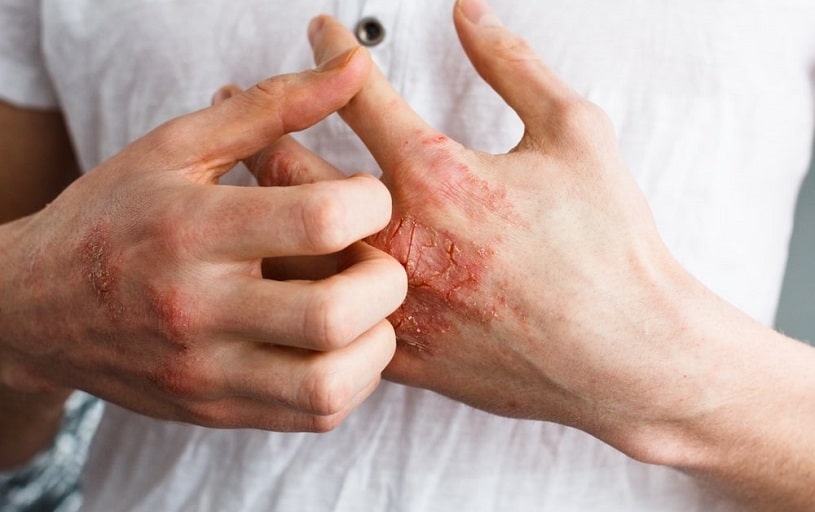Crystal meth, or simply meth, is a highly addictive neurotoxic drug made from amphetamine. It is a synthetic substance with a potent effect on the brain and central nervous system. Addiction to methamphetamine leads to serious consequences. Users are often referred to by derogatory terms such as meth head and speed freak. The devastating effects of methamphetamine abuse and addiction are all too apparent in many addicts, including meth bugs, scabs, and meth mouth. The most common effects of this drug are crystal meth sores and mites.
Table Of Contents:
What Are Crystal Meth Sores?
One of the effects of meth use is hallucinations and delusions. This leads a person to believe bugs are crawling under their skin and makes them scratch themselves, causing lesions. These lesions can get infected. Another cause of the sores comes from the body’s ability to identify this drug as toxic and its effort to remove it from the system via pores. When on the surface of the skin, it gives rise to pimple-like bumps. These lesions start off looking like small pimples and become dry and turn into small red spots. When the addict picks and scratches them, they become sores that are prone to infection. The sores do not heal easily once they appear because the immune system of an addict is affected by the repeated use of this drug. Staph that is commonly found on the body can avail the opportunity and cause infection in the open wounds.
Some of these sores become infected and swollen open wounds that bleed and become filled with pus. If sores progress to abscesses, they require medical therapy to heal. Because of the addict’s poor immunity and reduced blood flow, healing is slow. Scars may form on the site of previous sores. Methamphetamine scars are more apparent in addicts with undernourished skin and poor overall health.
The Following Are the Features Of Crystal Meth Sores:
- Users scratch their skin with their nails
- Users may also use scissors, knives, and other sharp objects when the sensation becomes unbearable
- Scratching and digging can lead to open wounds
- The sores are difficult to heal because the drug destroys blood vessels and tissues
- The sores increase the risk of infection
Meth sores are a visible and unmistakable sign of methamphetamine abuse.
What Do Meth Sores Look Like?
The crystal meth sores can appear as dots, acne, rash, burn, bite, blister, burn or scab, depending on the part of the body where they form. Their appearance can also change when they get infected. They can be found anywhere on the skin, including the neck, face, arm, and other body parts. The sores give an unappealing look to a person, especially when they appear on the face.
The terrible thing about skin effects of this drug is how rapidly the sores form and spread. They almost invariably become visible on the skin of people who suffer from drug abuse. The Multnomah County Sheriff’s Office in Oregon has published photos of methamphetamine addicts to show a meth face’s disturbing appearance. This was done in partnership with the Faces of Meth program to show the effects of methamphetamine use. The idea was that the before and after photos would serve as a deterrent to people who are using the drug or thinking about using the drug.
What Are Meth Mites?
Meth mites refer to the hallucinations experienced by chronic users in which they feel as though bugs are crawling under their skin. Some users report seeing the mites. Meth mites are not real, but rather a side effect of the chemicals present in methamphetamines that cause the addict’s skin to dry out. The dry skin leads to delusional parasitosis, which is a psychological effect of chronic methamphetamine abuse.
The official terminology for the sensation of bugs crawling under the skin is formication. The obsessive picking of the skin due to hallucinations often causes the user’s skin to become covered in small sores known as crystal meth sores. These skin lesions are not contagious like shingles or chickenpox. Addicts experience constant itching and scratching and tend to use their fingernails and even sharp instruments to pick at the mites.
Not all addicts experience this side effect, and there is no specific time frame when this effect occurs. Some users experience it when they first use methamphetamine, while others do not. Mites can be experienced anywhere on the body but most commonly occur on the face, chest, and upper arms.
Meth Effects on Skin
Methamphetamine is a dangerous drug that alters the addict’s facial appearance through both physical and psychological effects. Therefore, users of this drug have to fight its effects on two fronts. Even small doses of methamphetamine can result in widespread acne due to the drug’s drying effect. The psychological effects of the drug include hallucinations with a sensation of crank bugs crawling under the skin. This inevitably leads to incessant itching and scratching.
Meth Effects On Skin And General Appearance Are As Follows:
- Sores
- Pale appearance
- Wrinkles
- Dry and rough skin
- Gaunt and skeletal face
- Peeled skin with infections
- An unappealing look of teeth
- Sores on the face give an unappealing look
- Weak appearance due to weight loss
- Untidy appearance due to lack of personal hygiene
Drug abuse invariably weakens the addict’s immune system. The individual tends to show a pale appearance due to physical stress and frequent illnesses resulting from the weak immune system. The effects of methamphetamine on the skin are even more apparent when the drug is smoked. Smoking the drug causes the skin to wrinkle and become rough in texture.
Methamphetamine also causes or worsens acne due to dehydration and oil imbalance. The skin is irritable, dry, and pimple prone. Addicts often obsessively pick at pimples, sometimes creating large wounds. Poor personal hygiene, lack of sufficient water intake, and going without sleep for long periods all contribute to irritating the skin and clogging pores, which exacerbates acne.
The drug causes excessive sweating, which leads to dehydration and reduction in natural skin oils. This severe dehydration is responsible for the sensation of meth mites. Chronic addicts have meth mouth, i.e., the teeth are affected, and sores on the face and arms.
Methamphetamine has been found to suppress appetite, which leads to chronic malnourishment of the skin. Eventually, the muscle tissue and facial fat disappear, and this is responsible for the characteristic gaunt and skeletal methamphetamine face appearance of addicts.
Treatment For Meth Sores and Mites
The best cure for crystal meth sores and meth mites is to quit the drug, but until a person reaches that goal, some steps can be taken to relieve the symptoms. The first step is always to consult a doctor. Contacting drug and alcohol rehab programs can also be a good idea. It is essential to take care of proper personal and dental hygiene and maintain a healthy diet. A topical ointment prescribed by a doctor can be a good treatment. For acne, an over the counter medication can also be helpful. Natural oils, especially those containing vitamin E, can help soothe the skin. If the sore is infected, a doctor may prescribe antibiotics. Blisters might need draining, for which proper medical treatment should be obtained. Psychological therapy can help the addict quit the drug by addressing underlying mental conditions and dealing with the hallucinations and delusions.
Time To Get Help For Methamphetamine Addiction
The more addicts become engrossed in their addiction, the less likely they are to care for their bodies or observe personal hygiene. As a result, it is widespread to find users neglecting routine bathing, brushing their teeth, or eating a nutritious diet. By the time many addicts realize the destruction the drug is causing to their body, it is often too late to heal and return to normal health. Invariably, some permanent damage occurs.
The only cure for mites, sores, and other negative effects of methamphetamine use is quitting the drug altogether. Overcoming this addiction requires complete physical and mental transformation. Local drug and alcohol rehab programs can be helpful in this. Because of the immense damage it causes to the body, complete healing is not always possible. Treatment for methamphetamine addiction requires a physical detox. Once the addict’s body is rid of methamphetamine, a return to healthy habits is essential to allow the body to heal.
Methamphetamine addiction is not a hopeless situation. The rate of relapse is unfortunately high, but recovery is possible with behavior therapy and medical treatment. During the crystal methamphetamine detox and withdrawal process, the dopamine receptors in the addict’s brain grow back, but until this process is complete, it is not unusual for the recovering addict to experience profound depression. This depression must be treated with psychological therapy and prescription drugs to prevent relapse. Various treatment centers help ease the healing process and bring the recovery closer.
Page Sources
- Mcso.us. Faces of Meth. 2020. https://www.mcso.us/facesofmeth/main.htm
- National Institute on Drug Abuse. Meth Mouth and Crank Bugs: Meth-a-morphosis. 2020. https://archives.drugabuse.gov/blog/post/meth-mouth-and-crank-bugs-meth-morphosis
- Mihu MR, Roman-Sosa J, Varshney AK, Eugenin EA, Shah BP, Lee HH, Nguyen LN, Guimaraes AJ, Fries BC, Nosanchuk JD, Martinez LR. Methamphetamine alters the antimicrobial efficacy of phagocytic cells during methicillin-resistant Staphylococcus aureus skin infection. 2015. https://www.ncbi.nlm.nih.gov/pmc/articles/PMC4626859/
- Salamanca SA, Sorrentino EE, Nosanchuk JD, Martinez LR. Impact of methamphetamine on infection and immunity. Frontiers in neuroscience. 2015. https://www.ncbi.nlm.nih.gov/pmc/articles/PMC4290678/pdf/fnins-08-00445.pdf
- Mircea Radu Mihu, Jessica Roman-Sosa, Avanish K. Varshney, Eliseo A. Eugenin, Bhavikkumar P. Shah, Hiu Ham Lee, Long N. Nguyen, Allan J. Guimaraes,i Bettina C. Fries,j,k Joshua D. Nosanchuk, and Luis R. Martinez. Methamphetamine Alters the Antimicrobial Efficacy of Phagocytic Cells during Methicillin-Resistant Staphylococcus aureus Skin Infection. 2015. https://www.ncbi.nlm.nih.gov/pmc/articles/PMC4626859/

 Authored by
Authored by  Reviewed by
Reviewed by 



